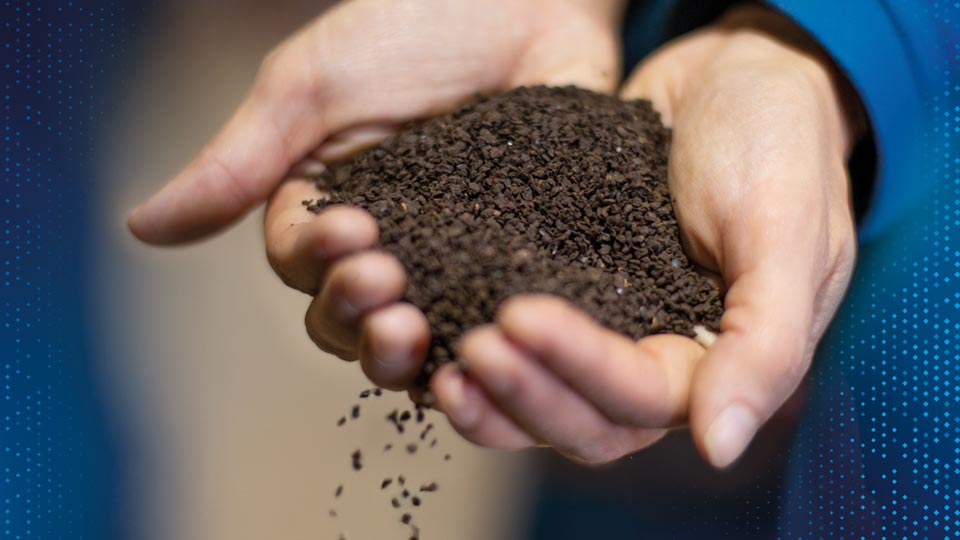
Improving phosphorus use efficiency in agriculture
Learn how AGTIV® mycorrhizal inoculants help plants achieve higher yields by improving P uptake, along with many other well-documented benefits.

Improving phosphorus use efficiency in agriculture
Learn how AGTIV® mycorrhizal inoculants help plants achieve higher yields by improving P uptake, along with many other well-documented benefits.
Phosphorus being such a critical nutrient for plant growth and metabolism, it is important to supply sufficient P to crops in order to achieve targeted yields. Growers invest a lot of money on fertilizers, respecting the 4Rs (right product, right rate, right time, right place) hoping for their crops to use them efficiently.
However, poor P availability, mobility and P runoff make the management of this nutrient a real struggle. Researchers around the globe are working on how crops can better access P from fertilizers or organic P complexes in agricultural soils.
Phosphorus (P) is one of the critical nutrients for plant growth, having an important impact on plant metabolism and photosynthesis, and it represents about 0.2% of plants' dry weight. P scarcity, as for any plant resource according to Liebig’s law of the minimum, may lead to different problems, including lower yield, even if other nutrients are available. In other words, you need sufficient phosphorus to grow plants.
Agricultural crops have the same need for P, especially in earlier stages of plant growth. “The fresh pea crop for instance, it only has a 60-day cycle, and we need the plant to be healthy for those 60 days, and AGTIV® quite often makes for better nutrient uptake and healthier plants which produce more peas”, says Brad Fife, Ontario grower.
Another example: potatoes show lower yield at harvest when subjected to P deficiencies, including smaller tubers, lower dry matter content, and more disease susceptibility. “The potato crop demands high phosphorus levels, due to its shallow roots, low root density, minimal root hairs, and high P demand in the shoots. P is the most critical major nutrient limiting potato growth after nitrogen and potassium in soils.”1
Pulse crops use P to promote the development of extensive root systems and vigorous seedlings, which have an impact on nodule development, and plays an important role in the nitrogen fixation process.2
As much as it is needed, P is also one of the most difficult nutrients to acquire. Why? Because in soil, it may be present in relatively large amounts, but most of it is poorly available because of the very low solubility of phosphate and its very low mobility.
Phosphorus, in mineral soils, quickly becomes unavailable as it binds to soil particles by sorption, is immobilized on organic matter or is precipitated as insoluble inorganic compound via Al, Fe or Ca; so, transformed in a state that plants are unable to use it. Also, P content in soil solution is very small due to its low water solubility, is fairly immobile and is rapidly depleted by plant uptake in the root zone. Optimum cultivated soil pH for P availability is between 6 and 7. At higher level, P tends to precipitate with calcium. At lower level, P tends to bind with Al and Fe. Mycorrhizae will allow the plant to have access to it. A little more on that later.
Furthermore, P concentration in root cells is about 1000 times higher than in the soil solution, so P uptake is not a passive process. A lot of energy is needed to transfer P from the soil solution into the plant. And that’s when P is available!
But what is the actual process by which plants uptake P? And how can we help plants reach and uptake more P when they need it the most?
Let’s answer by examining the biological process used by plants to acquire P (with the “direct pathway”), and by learning on how mycorrhizae (Arbuscular Mycorrhizal Fungi, or AMF) can help when it comes to P uptake (with the “mycorrhizal pathway”).
P uptake by plants (through the “direct pathway”) involves different regions of the roots and P transporters. The direct pathway is most effective immediately behind the apex, where the root epidermis, armed with high-affinity P transporters, grows into nondepleted soil.
Then, direct uptake declines, due to the reduced activity of P transporters in the epidermis, the decrease of root hair number, and the depletion of P in the rhizosphere. The depletion happens because P uptake is faster than its diffusion in bulk soil, meaning P isn’t mobile and quick enough to reach plants from afar.
Plants mostly have access to inorganic P near the roots and spend a lot of energy getting closer to available (but non-mobile) P. Soil microbes help plants in solubilizing organic P in the root solution, but most of this still happens close to roots, as microbes tend to gather along plant roots to feed on carbon exuded by the plant.
If only plants had a way to reach P further, and get more collaboration from soil microbes…
Mycorrhizal fungi will improve the phosphorus use efficiency, by:
When a plant is colonized by arbuscular mycorrhizal fungi (AMF), fungal hyphae will establish their own pathway (the “mycorrhizal pathway”). The role of uptaking P and transferring it to plants is what led AMF to maintain such an important role in plant evolution. The mycorrhizal pathway will come into play and rapidly contribute to plant P uptake, with as high as 80% of the P uptake of the plant.
Mycorrhizal hyphae have a much smaller diameter than roots, allowing them to access narrower soil pores, hence increasing the explored soil volume. Mycorrhizal hyphae also explore soil much further than roots, accessing soil outside of the depletion zone.
Mycorrhizal hyphae not only access nutrients and water further than roots, but the uptake process is also more efficient. In fact, hyphae are constituted of chitin that is more permeable to water and nutrients than root cellulose, rendering the process less energy-consuming.
P is taken up by AMF hyphae by fungal P transporters several centimeters from the roots and translocated quickly to intracellular fungal structures (arbuscules or hyphal coils) in root cortical cells. Plant P transporters, induced in colonized cells, transfer P from intracellular fungal structures to plant cortical cells. In other words, the plant doesn’t have to work to get P inside its roots, as AMFs (mycorrhizae) are doing the job.
It is known that the presence of mycorrhizae in the soil improves phosphate solubility by releasing enzymes (such as organic acid or phosphatase) breaking the insoluble P complex and enhancing the establishment of bacteria, many of which secrete phosphate-solubilizing enzymes.
The activity of soil microbes releases the immobile forms of P to soil solution which is then made available to the plants or AMF. Phosphate solubilizing bacteria (PSB) are present in most soil and solubilize phosphate via phosphatase, by lowering the soil pH and/or by chelating phosphate from soil minerals, such as iron and aluminum in acidic soils and calcium in alkaline soils.
AMF and PBS synergistically interact, as bacteria thrive in close vicinity of AMF extraradical hyphae and intimately cooperate with AMF by providing inorganic minerals (e.g. phosphate) released from organic matter in decomposition in exchange for carbon exuded by the hyphae.
DISCOVER THE MYCORRHIZAL PRODUCTS
Sources:
1 Jasim et al., Potato Phosphorus Response in Soils with High Value of Phosphorus, 2020, Agriculture, 10, 264.
2 Barker, B., Phosphorus management for pulses, Saskatchewan Pulses Growers, https://saskpulse.com/files/general/160401_Phosphorus_management_for_pulses2.pdf
Other sources:

This year marks a significant milestone for Premier Tech as we proudly celebrate 10 years of the AGTIV® brand.

Premier Tech Growers and Consumers is proud to share that all AGTIV® granular inoculants feature Premier Tech peat granules, a testament to the company’s full integration of the production process of our finished goods.